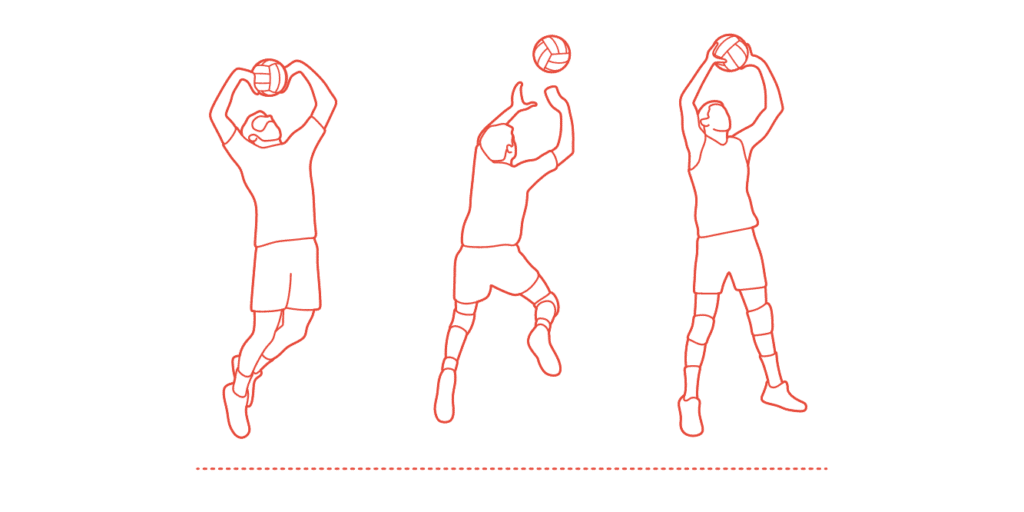Volleyball is a fast-paced, dynamic sport that requires exceptional teamwork, skill, and strategy. One of the most crucial roles in a volleyball team is that of the setter.
Often referred to as the “quarterback” of the team, the setter is responsible for orchestrating the offense and setting the stage for their teammates to score points.
A great setter can elevate the performance of the entire team, turning an average squad into a formidable force on the court.

In this article, we will delve into the importance of the setter position in volleyball, explore the key skills and techniques required for success, and provide valuable tips and strategies to help aspiring setters reach their full potential.
By understanding the critical role of a setter and mastering the necessary skills, you can take your game to new heights and become an indispensable asset to your team.
Volleyball Setter Position
Importance Of The Setter Position In Volleyball
The setter position is of paramount importance in volleyball as they are the linchpin of the team’s offense. Their primary responsibility is to receive the second ball in a play and accurately set it up for their teammates to attack.

The setter’s ability to deliver precise and well-timed sets is crucial for the team’s success, as it directly impacts the effectiveness of the hitters and the overall offensive flow of the game.
A skilled setter must possess exceptional technical abilities, tactical awareness, and strong leadership qualities.
They need to be able to read the opposing team’s defense, make quick decisions, and execute their sets with finesse and accuracy.
Their performance not only affects the outcome of individual plays but also sets the tone for the entire match.
In essence, the setter is the team’s strategic mastermind, turning defensive plays into offensive opportunities and keeping the opposition on their toes.
Setters Don’t Usually Pass
Setters play a critical role in running the offense and setting up their teammates for successful attacks.
As a result, their primary focus is on setting the ball, and they typically don’t participate in the first contact or passing phase of a play. In this section, we will delve into the reasons behind this strategy and its advantages for the team.
- A. Setters need to be ready and available to set the ball for their teammates, and having their hands free allows them to be in the best position to do so.
- B. By not participating in passing, setters can focus on observing the opposing team’s defense, analyzing the situation, and preparing for their setting responsibilities.
- C. Keeping the setter hands-free also reduces the risk of overloading them with multiple tasks, which could potentially compromise their performance as the team’s offensive leader.
Setters Are Responsible For Every Second of Ball
Setters are responsible for every second ball, ensuring the team’s offense runs smoothly. Their primary task is to receive the pass from their teammates and accurately set it for the hitters to attack.
By handling the second ball consistently and effectively, setters play a crucial role in maintaining the offensive tempo and creating scoring opportunities for their team.
Does The Setter Always Get The Second Ball?
While the setter is generally expected to take the second ball, there are situations where they may not be able to do so, such as when they are out of position or have received the first ball themselves.
In these cases, another player, often the libero or a designated backup setter, will step in to set the ball. This requires teams to have a solid understanding of their roles and be prepared to adapt quickly during gameplay.
The role of a setter in creating offensive opportunities
The role of the setter goes beyond just delivering the ball to their teammates; they must also create offensive opportunities by outsmarting the opposing team’s defense.
This involves understanding the strengths and preferences of their own hitters, as well as the weaknesses and tendencies of the opposition’s blockers and back-row defenders.
Setters are responsible for choosing the type of set and the target hitter for each play, taking into consideration the game situation, the rotation, and the matchups between their hitters and the opponent’s blockers.
By varying the height, speed, and location of their sets, a setter can create openings in the defense and enable their hitters to attack with greater efficiency and success.
Moreover, a setter can employ deceptive tactics such as disguising their intentions, using quick sets, and even executing surprise attacks like setter dumps to keep the defenders guessing.
A creative and unpredictable setter can force the opposing team to commit errors or create mismatches that can be exploited by their teammates. Ultimately, the setter’s ability to create offensive opportunities is a vital component of a winning volleyball team.
Essential Skills for a Volleyball Setter
A. Ball control and accurate setting
One of the fundamental skills for a volleyball setter is ball control, which enables them to deliver accurate and consistent sets to their hitters. A great setter must have excellent hand-eye coordination, touch, and precision to manipulate the ball effectively.
They need to be adept at setting the ball with the right height, speed, and direction for each type of attack, adjusting their technique to suit the needs of their teammates and the tactical situation.
Additionally, a setter must be able to handle different types of passes, including imperfect or off-target receptions, and still deliver a playable set for their hitters.
- Image: Setter performing a perfect set
B. Decision-making and play-calling
A successful setter must be a quick thinker and possess strong decision-making skills. They are responsible for choosing the most appropriate set and hitter based on the game situation, matchups, and the opposing team’s defensive alignment.
Setters need to be able to assess the state of play in an instant, consider various factors, and make split-second decisions that maximize their team’s chances of scoring.
Good judgment and strategic acumen are essential for a setter to outsmart the opposition and create offensive opportunities.
C. Communication and leadership
Effective communication and leadership are crucial for a setter, as they are the on-court conductor of the team.
A setter must clearly communicate with their teammates, both verbally and through hand signals, to coordinate the offense and ensure everyone is on the same page.
They should be able to motivate and inspire their teammates, instill confidence, and maintain a positive and focused attitude. A great setter leads by example, stays calm under pressure, and demonstrates a strong work ethic and commitment to the team’s success.
D. Anticipation and reading the opposing team’s defense
Anticipation and the ability to read the opposing team’s defense are vital skills for a setter.
By observing the movements and positioning of the blockers and back-row defenders, a setter can predict their intentions and exploit any vulnerabilities in the defensive setup.
This enables them to make informed decisions when calling plays and setting the ball, increasing the likelihood of successful attacks. A keen sense of anticipation also helps the setter react quickly to unexpected situations, such as covering a blocked attack or adjusting to a poor pass.
E. Agility, footwork, and physical fitness
While setters may not be the tallest or most powerful players on the court, they need to have exceptional agility, footwork, and physical fitness. Quick and efficient footwork is crucial for a setter to move to the ball and establish a stable, balanced position for setting.
They must also possess the stamina and endurance to maintain a high level of performance throughout the match, as well as the strength and flexibility to execute their sets effectively.
Training in these areas can significantly enhance a setter’s overall game and contribute to their team’s success.
Key Setter Techniques and Tactics
A. The traditional set
The traditional set, also known as the overhead set, is the most fundamental and commonly used setting technique.
It involves the setter positioning their hands above their forehead, with their fingers forming a triangle shape to cradle the ball.
They then extend their arms and wrists to propel the ball toward the desired target. Consistency and accuracy in executing the traditional set are crucial for a setter to be effective on the court.
- Image: A step-by-step breakdown of the traditional set technique
B. Back-setting and front-setting
In addition to the traditional set, setters should be proficient in back-setting and front-setting.
Back-setting involves setting the ball behind the setter to a hitter positioned on the right side of the court, while front-setting directs the ball toward a hitter on the left side.
Both techniques require the setter to be deceptive in their body movements, making it difficult for the opposing blockers to anticipate the direction of the set.
C. Jump setting and quick tempo sets
Jump setting and quick tempo sets are advanced techniques that can add variety and speed to a team’s offense.
A jump set is executed by the setter jumping and setting the ball at the peak of their jump, making it harder for the blockers to react.
Quick tempo sets, on the other hand, involve setting the ball at a faster pace and lower height, enabling the hitters to attack before the defense has time to prepare. These techniques require excellent timing, coordination, and precision from both the setter and the hitters.
D. Setter dumps and sneaky offensive plays
To keep the opposition guessing, setters should also develop sneaky offensive plays, such as setter dumps.
A setter dump is a surprise attack where the setter, instead of setting the ball for a teammate, sends it directly over the net into an open space on the opponent’s court.
This tactic can be highly effective when the opposing team’s defense is expecting a traditional set, as it can catch them off-guard and score quick points.
- Image: Setter executing a dump over the net
E. Establishing a connection with hitters
One of the most important aspects of being a successful setter is establishing a strong connection with the team’s hitters.
This involves understanding each hitter’s preferences, strengths, and weaknesses, as well as developing a rapport and trust that allows for seamless cooperation during matches.
By knowing when and how to set the ball for each hitter, the setter can maximize their teammates’ potential and create a more efficient and cohesive offense.
Practicing together, communicating openly, and fostering a supportive team environment can help setters and hitters build a strong connection that translates to success on the court.
Characteristics of a Good Volleyball Setter
Analytical Mindset:
A standout setter is the quarterback of the team, requiring sharp analytical skills.
Decisions need to be made swiftly, considering both the team’s dynamics and the opponent’s strengths and weaknesses.
The ability to read the game, adjust strategies, and optimize offensive opportunities distinguishes an exceptional setter.
Confidence and Decisiveness:
In the fast-paced world of volleyball, hesitation is the enemy. A top-tier setter exudes confidence and decisiveness, making split-second choices with conviction.
Even when decisions may seem questionable to onlookers, a confident setter stays committed to their plan, fostering trust with teammates and maintaining a winning mindset.
Leadership and Communication
Given that setters touch the ball more than anyone else, effective communication is paramount.
A skilled setter is a natural leader, orchestrating plays and guiding teammates. Open and honest communication with both coaching staff and players is essential, fostering a cohesive and supportive team environment.
Encouragement during challenging moments is a hallmark of a setter’s leadership.
Adaptability
Running an offense doesn’t always unfold as planned. A proficient setter embraces adaptability, ready to adjust tactics when faced with challenges.
Whether a hitter is having an off day or the opposing team displays formidable defense, the setter’s ability to switch up strategies and keep opponents guessing is crucial to success.
Selflessness
In a sport where hitters often bask in the spotlight, a selfless setter stands out. While hitters receive praise for spectacular plays, a setter finds fulfillment in their teammates’ success.
Acknowledging that their role is to set the stage for others allows a setter to excel, placing team achievements above personal recognition.
Conclusion:
To sum it up, a remarkable volleyball setter embodies analytical prowess, confidence, leadership, adaptability, and selflessness.
This challenging yet pivotal position requires a Gryffindor-like spirit, unafraid to make bold decisions and lead the team to victory.
Whether you’re considering playing as a setter or appreciating the strategic nuances as a spectator, understanding these traits enriches your volleyball experience.
